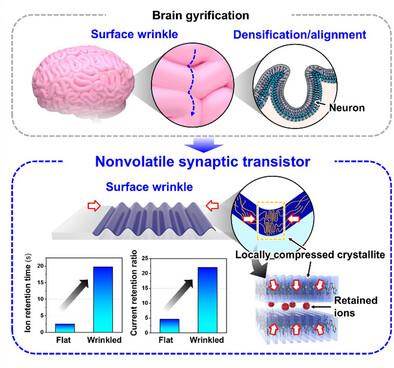Brain‐Inspired Topological Surface Modulation for Advanced Nonvolatility in Organic Artificial Synapses
IF 12.1
2区 材料科学
Q1 CHEMISTRY, MULTIDISCIPLINARY
引用次数: 0
Abstract
Human intelligence has evolved dramatically as topological adaptations have taken precedence over volumetric expansion in brain development. Inspired by the remarkable functional enhancements achieved through cortical gyrification, organic synaptic transistors (OSTs) are demonstrated with active layers engineered via controlled surface topologies. Macroscopic compressive forces induce wrinkling in the active polymer layer, generating localized stress that compresses microscopic crystallites. This compression effectively enhances ion retentivity in the OST, leading to improved long‐term plasticity (LTP) and greater linearity in synaptic responses compared to uncompressed crystallites. The OST with an optimized topological structure in its active layer exhibits a fourfold enhancement in LTP, successfully emulating paired‐pulse facilitation and five key synaptic functions of the human neural system. As a result, simulations of image recognition based on the convolutional neural network demonstrate high accuracy, underscoring the potential of topological control in hardware for artificial neural network computing.

脑启发的拓扑表面调制用于有机人工突触的高级非挥发性
在大脑发育过程中,拓扑学适应优先于体积扩张,人类智力发生了戏剧性的进化。受皮层旋转所实现的显著功能增强的启发,有机突触晶体管(OSTs)通过控制表面拓扑结构来设计有源层。宏观压缩力诱导活性聚合物层起皱,产生局部应力,压缩微观晶体。与未压缩的晶体相比,这种压缩有效地增强了OST中的离子保留力,从而改善了长期可塑性(LTP)和突触反应的更大线性。活性层拓扑结构优化后的OST显示LTP增强了4倍,成功模拟了人类神经系统的成对脉冲易化和5个关键突触功能。因此,基于卷积神经网络的图像识别仿真显示出较高的准确性,强调了人工神经网络计算在硬件拓扑控制方面的潜力。
本文章由计算机程序翻译,如有差异,请以英文原文为准。
求助全文
约1分钟内获得全文
求助全文
来源期刊

Small
工程技术-材料科学:综合
CiteScore
17.70
自引率
3.80%
发文量
1830
审稿时长
2.1 months
期刊介绍:
Small serves as an exceptional platform for both experimental and theoretical studies in fundamental and applied interdisciplinary research at the nano- and microscale. The journal offers a compelling mix of peer-reviewed Research Articles, Reviews, Perspectives, and Comments.
With a remarkable 2022 Journal Impact Factor of 13.3 (Journal Citation Reports from Clarivate Analytics, 2023), Small remains among the top multidisciplinary journals, covering a wide range of topics at the interface of materials science, chemistry, physics, engineering, medicine, and biology.
Small's readership includes biochemists, biologists, biomedical scientists, chemists, engineers, information technologists, materials scientists, physicists, and theoreticians alike.
 求助内容:
求助内容: 应助结果提醒方式:
应助结果提醒方式:


